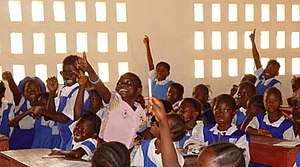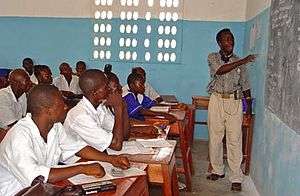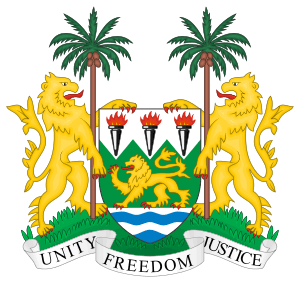Education in Sierra Leone
Education in Sierra Leone is legally required for all children for six years at primary level and three years in junior secondary education,[1] but a shortage of schools and teachers has made implementation impossible.[2] The Sierra Leone Civil War resulted in the destruction of 1,270 primary schools and in 2001 67 percent of all school-age children were out of school.[2] The situation has improved considerably since then with primary school enrollment doubling between 2001 and 2005 and the reconstruction of many schools since the end of the war.[3] However, there is still a long ways to go. In 2004, Junior secondary school enrollment was only 17% of primary school enrollment, and senior secondary school enrollment was only 8% of primary school education.[4]

History

During the nineteenth century, Sierra Leone was a pioneer of western-style education in sub-Saharan Africa. Fourah Bay College, affiliated with Durham University in the United Kingdom, was founded in 1827 as the first tertiary educational institute in the region. The first boys school, Sierra Leone Grammar School, and the first girls school, Annie Walsh Memorial School, were founded in 1845 and 1849 respectively.The country was an important centre in training teachers, doctors and administrators for whole of West Africa in the first half of the nineteenth century.[5]
The education system that developed in Sierra Leone during the nineteenth and twentieth century was styled on the British education system. It was elitist in nature aimed at urban middle class and focused on the academically gifted who would go on to tertiary education before taking up positions as civil servants in the government. During this period the majority of the population were not formally educated or only a couple of years of primary education. When Sierra Leone declared independence in 1961, under 15% of children aged five to eleven and only five percent of 12- to 16-year-olds attended school.[6]
After independence there was pressure to change the education system, but it wasn't until the 1990s that this grew to the level that led to changes in the system. Reforms were proposed so that the education system would serve the social economic needs of the country more closely, centering on increasing access to education, particularly primary education and placing more emphasis on technical and vocational education. In 1993 the government adopted a four-stage approach to education and created the National Commission for Basic Education.[6]
During the 1990s the Sierra Leone Civil War set these goals back destroying much of the country's infrastructure including schools; for example, 1,270 primary schools were destroyed.[2] This created a shortage in schools which was compounded by a shortage in teachers and so made the legal requirement of universal basic education for all children difficult to obtain. At the end of the war in 2001 67 percent of school-age children were out of school.[2]
The generation of child soldiers that came out of the Sierra Leone Civil War also set these goals back, as they had to be reintegrated into their community. There are thousands of former soldiers in Sierra Leone that have a hard time reintegrating into their communities after experiencing the atrocities of war.[7] Almost 7,000 child soldiers were demobilized during the UN Mission in Sierra Leone (UNAMSIL).[8] At the end of the war, disarmament, demobilization, and reintegration programs (DDR)[9] were introduced to the country. These programs aim to socialize the children in a way that prepares them to return to their communities. The Complementary Rapid Education for Primary Schools (CREPS) program serves children age 16 and older, and at its peak, served 11,663 children from 2002-2003.[7] Another DDR program, the Rapid Response Education Program (RREP), ended in 2002 after providing for 7,115 children at its peak from 2001-2002.[7] Although the DDR programs in Sierra Leone work towards the reintegration of the generation of child soldiers, there is little evidence to date that long-term reintegration has occurred as a direct result from them.[10]
Structure
Sierra Leone's education system is divided into four stages; primary education lasting six years, junior secondary education of three years, three years of either senior secondary education or technical vocational education and four years of university or other tertiary education.[11]
The 2004 Education act abolished school fees for all children at primary school and at junior secondary school for girls in the northern and eastern areas. Fees were also abolished for the National Primary School Examination (NPSE) that is taken at the end of primary school which, along with the increase in school enrollment, led to 78,000 students taking the exam in 2005 compared with 26,000 in 2001. The NPSE is designed by the West African Examination Council and has to be passed in order to progress to secondary education.[12]
Primary education
The number of children receiving primary education has greatly increased since the end of the civil war. However, in 2007, there were still more than 240,000 children, about 25%-30% of the population of this age group, not receiving education. The rate of completion of primary education is also low with only 64% of children completing their primary education during 2004/05. The educational attainment of girls is below this level partly due to cultural beliefs in some areas of Sierra Leone that do not support the education of girls.[13]
| Measure | Bo[14] | Bombali[15] | Bonthe[16] | Kailahun[17] | Kambia[18] | Kenema[19] | Koinadugu[20] | Kono[21] | Moyamba[22] | Port Loko[23] | Pujehun[24] | Tonkolili[25] |
|---|---|---|---|---|---|---|---|---|---|---|---|---|
| Number of primary schools | 462 | 437 | 141 | 310 | 294 | 559 | 278 | 236 | 438 | 463 | 291 | 489 |
| Schools in good condition | 302 | 274 | 100 | 119 | unknown | 302 | 57 | 195 | unknown | unknown | 95 | 144 |
| Primary enrollment | 148,538 | 121,731 | 40,728 | 87,124 | 45,653 | 171,885 | 69,424 | 67,907 | 93,497 | 144,858 | 71,120 | 113,926 |
| Male enrollment | 77,473 | 66,237 | 21,238 | 45,992 | unknown | 89,948 | 38,152 | 35,240 | 49,031 | 73,639 | 38,328 | 59,410 |
| Female enrollment | 71,065 | 57,232 | 19,490 | 41,132 | unknown | 81,937 | 31,272 | 32,667 | 44,466 | 71,219 | 32,792 | 54,516 |
| Number of primary teachers | 1,597 | 2,212 | 632 | 1,624 | unknown | 3,135 | 907 | 710 | 1,918 | 1,595 | 1,001 | 2,379 |
| Qualified primary teachers | 1,293 | 898 | 213 | 698 | unknown | 1,589 | 163 | 255 | 582 | 838 | 300 | 683 |
Secondary education

Secondary school examinations in government-funded schools (and many private schools) are coordinated by the West African Examinations Council. This council implements the Basic Education Certificate Examination and the West African Senior School Certificate Examination.
Tertiary education
There are two universities in Sierra Leone: the University of Sierra Leone, founded as Fourah Bay College in 1827; and Njala University which was established as the Njala Agricultural Experimental Station in 1910 and became a university in 2005.[26]
In addition, The Evangelical College of Theology, founded in 1964, is accredited by the University of Sierra Leone and the Tertiary Education Committee for both the Diploma and Bachelor level.
Adult education
Sierra Leone has a low level of literacy among adults with only 37.1% of adults literate in 2006, the level of literacy is higher among 15- to 24-year-old who have a literacy rate of 52.2%. For both groups literacy among women is much lower than that for men.[27] Attendance within the education system is also low among adults with men averaging 4 years of formal education and women 2 years.[28]
References
- Wang, p. 2
- "Sierra Leone" Archived November 2, 2013, at the Wayback Machine. 2001 Findings on the Worst Forms of Child Labor. Bureau of International Labor Affairs, U.S. Department of Labor (2002). This article incorporates text from this source, which is in the public domain.
- Wang, p. 1 and 3
- Betancourt, Theresa S.; Simmons, Stephanie; Borisova, Ivelina; Brewer, Stephanie E.; Iweala, Uzo; de la Soudière, Marie (July 30, 2008). "High Hopes, Grim Reality: Reintegration and the Education of Former Child Soldiers in Sierra Leone". Comparative Education Review. 52 (4): 565–587. doi:10.1086/591298. ISSN 0010-4086. PMC 2662600. PMID 19337570 – via JSTOR.
- Wang, p. 33-34
- Wang, p. 34
- Betancourt, Theresa S.; Simmons, Stephanie; Borisova, Ivelina; Brewer, Stephanie E.; Iweala, Uzo; de la Soudière, Marie (July 30, 2008). "High Hopes, Grim Reality: Reintegration and the Education of Former Child Soldiers in Sierra Leone". Comparative Education Review. 52 (4): 565–587. doi:10.1086/591298. ISSN 0010-4086. PMC 2662600. PMID 19337570.
- Dobbins et. all, James (June 10, 2013). ""Sierra Leone."". Overcoming Obstacles to Peace: Local Factors in Nation-Building: 151–178 – via JSTOR.
- Humphreys, Macartan; Weinstein, Jeremy M. (2007). "Demobilization and Reintegration". The Journal of Conflict Resolution. 51 (4): 531–567. doi:10.1177/0022002707302790. ISSN 0022-0027. JSTOR 27638565.
- Banya, Kingsley (January 1993). "Illiteracy, Colonial Legacy and Education: the case of modern Sierra Leone". Comparative Education. 29 (2): 159–170. doi:10.1080/0305006930290204. ISSN 0305-0068.
- Government of Sierra Leone (2004), The Education Act 2004 (PDF), Sierra Leone: Sierra Leone Encyclopedia, p. 4, archived from the original (PDF) on April 15, 2012, retrieved 2008-06-25
- Wang, p. 2-3 and 35
- ActionAid (2007), ActionAid Sierra Leone:KEY AREAS OF WORK… (PDF), Sierra Leone Encyclopedia, p. 3, retrieved 2008-06-28
- Ministries, Departments and Agencies (MDAs) in Bo District, Bo District Statistics, Sierra Leone Encyclopedia, archived from the original on 2008-08-28, retrieved 2008-06-28
- Ministries, Departments and Agencies (MDAs) in Bombali District, Bombali District Statistics, Sierra Leone Encyclopedia, retrieved 2008-06-28
- Ministries, Departments and Agencies (MDAs) in Bonthe District, Bonthe District Statistics, Sierra Leone Encyclopedia
- Ministries, Departments and Agencies (MDAs) in Kailahun District, Kailahun District Statistics, Sierra Leone Encyclopedia
- Ministries, Departments and Agencies (MDAs) in Kambia District, Kambia District Statistics, Sierra Leone Encyclopedia
- Ministries, Departments and Agencies (MDAs) in Kenema District, Kenema District Statistics, Sierra Leone Encyclopedia
- Ministries, Departments and Agencies (MDAs) in Koinadugu District, Koinadugu District Statistics, Sierra Leone Encyclopedia
- Ministries, Departments and Agencies (MDAs) in Kono District, Kono District Statistics, Sierra Leone Encyclopedia
- Ministries, Departments and Agencies (MDAs) in Moyamba District, Moyamba District Statistics, Sierra Leone Encyclopedia
- Ministries, Departments and Agencies (MDAs) in Port Loko District, Port Loko District Statistics, Sierra Leone Encyclopedia
- Ministries, Departments and Agencies (MDAs) in Pujehun District, Pujehun District Statistics, Sierra Leone Encyclopedia
- Ministries, Departments and Agencies (MDAs) in Tonkolili District, Tonkolili District Statistics, Sierra Leone Encyclopedia
- Njala University College (Nuc), Sierra Leone: Sierra Leone Encyclopedia, July 2007, archived from the original on 2007-03-11, retrieved 2008-06-25
- UIS STATISTICS IN BRIEF:Education in Sierra Leone, UNESCO Institute for Statistics, 2006, retrieved 2008-06-25
- Wang, p. 24
Bibliography
- Wang, Lianqin (2007). Education in Sierra Leone: Present Challenges, Future Opportunities, World Bank Publications, ISBN 0-8213-6868-0
